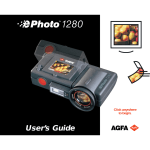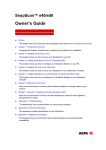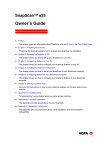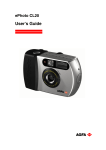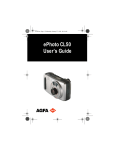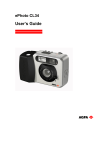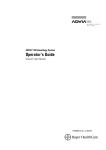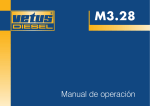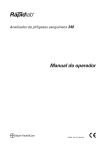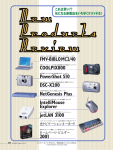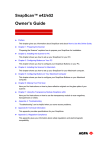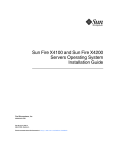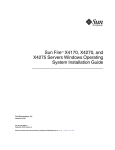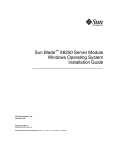Download AGFA 780 Digital Camera User Manual
Transcript
Quick-Start Reference User’s Guide FCC INFORMATION FCC WARNING: This equipment meets the limits for a Class B digital device, pursuant to Part 15 of FCC Rules. Only the power pack and cable supplied with the camera should be used. Operation with other power packs and cables is likely to result in interference to radio and TV reception and could void the user’s authorization to operate this equipment. This device complies with Part 15 of the FCC Rules. Operation is subject to the following two conditions: 1) This device may not cause harmful interference. 2) This device must accept any interference received, including interference that may cause undesired operation. Changes or modifications not expressly approved by the manufacturer may void the user’s authority to operate this equipment. USER INFORMATION NOTE: This equipment has been tested and found to comply with the limits for a Class B digital device, pursuant to Part 15 of the FCC Rules. These limits are designed to provide reasonable protection against harmful interference in a residential installation. This equipment generates, uses and can radiate radio frequency energy and, if not installed and used in accordance with the instructions, may cause harmful interference to radio communications. However, there is no guarantee that interference will not occur in a particular installation. If this equipment does cause harmful interference to radio or television reception, which can be determined by turning the equipment off and on, the user is encouraged to try to correct the interference by one or more of the following measures: – Reorient or relocate the receiving antenna. – Increase the separation between the equipment and receiver. – Connect the equipment into an outlet on a circuit different from that to which the receiver is connected. CANADIAN RADIO INTERFERENCE REGULATIONS STATEMENT This Class B digital device meets all the requirements of the Canadian Interference-Causing Equipment Regulations. Cet appareil numérique de la Classe B respecte toutes les exigences du Règlement sur le matériel brouilleur du Canada. 1-YEAR LIMITED HARDWARE WARRANTY Agfa warrants this product to be free from defects of material and workmanship for one (1) year from the date of purchase. During the warranty period, Agfa will repair or replace, at its option, the product at no charge to the customer. The replacement unit may be a remanufactured unit or a unit of equal or greater functionality. After one (1) year, Customer shall pay for all parts, labor and service. Agfa warrants that software products will conform to published specifications in effect at the time of delivery for 90 days after purchase. Customer acknowledges that the Software may have inherent defects because of its complexity. The warranty applies only to the media on which the software is recorded. If a unit is replaced during the warranty period, the original warranty shall remain in effect until the end of the one (1) year period or shall be 30 days, whichever is longer. This warranty is transferable with new owner notification to Agfa. This warranty shall not apply if Customer: (1) abuses or modifies Product or Software; (2) operates the system in an environment with excessive dirt, moisture, chemical fumes, extremes of temperature or other improper conditions. The camera is not impermeable to water, dust or sand, or (3) supplies other Software or Interfacing. Warranty service is excluded if the serial number of the product has been tampered with or removed. THE PARTIES AGREE THAT ALL OTHER WARRANTIES, EXPRESS OR IMPLIED, INCLUDING WARRANTIES OF FITNESS FOR A PARTICULAR PURPOSE, MERCHANTABILITY AND NON-INFRINGEMENT, ARE EXCLUDED. Copyright © 1998 Bayer Corporation. All rights reserved. Using This Document To move around in this document, you can click on the special navigation symbols at the bottom of each page: Go to the previous page Return to the Contents page Go to the next page You can also click on any underlined text in blue to go to the page for that topic (e.g. Quick-Start or Reference). To print some or all of this guide, select Print from the File menu. When you are finished reading this page, return to the page you were on by pressing z – (Mac) or Alt – (PC). Quick-Start This section of the User’s Guide gives you a fast overview of how to use your ePhoto 780 to take pictures and review them on the camera. The Reference section of this guide contains more in-depth information about the ePhoto 780. ! Note: For hints on using this file most effectively, click here. Step 1: Turn on the Camera To turn on the camera, slide the lens cover open. ! Note: Make sure you are familiar with the parts of your camera. Step 2: Review the Settings Review the camera settings by looking at the LCD panel on top of the camera. Step 3: Change the Settings as Needed To change the resolution for your pictures, press the Resolution button repeatedly until the setting you want is shown in the Status Display: 1 Quick-Start (cont.) ◗ ◗ ◗ ◗ . .. ... .... 320 x 240 pixels (lowest resolution) 640 x 480 pixels with moderate compression 640 x 480 pixels with low compression 780 mode, 1024 x 768 pixels (highest resolution) To change the flash mode, press the Flash button repeatedly until the mode you want is shown: ◗ Off (No flash used) ◗ Auto (Flash used as needed) ◗ Red-eye (Automatic flash with pre-flash to reduce “red-eye” effect) ◗ Forced (Flash always used) Step 4: Frame the Picture To frame the picture, look through the optical viewfinder. OR Press the Video Viewfinder button. The LCD screen now acts as a viewfinder. 2 Quick-Start (cont.) Step 5: Take the Picture To take the picture while looking at the optical or video viewfinder, press the shutter button fully. The camera beeps and the image is stored in a few seconds. Step 6: Review the Stored Image After a few seconds, the picture you just took is displayed on the LCD screen. If you want to delete the picture, press the button next to Delete now. If you have taken more than one picture, you can scroll through all the images continuously using the ¶ and Ä buttons. To take a picture while reviewing stored images, just press the shutter button. More Information The Reference portion of this User’s Guide contains much more detailed information about the features of your ePhoto 780, including: 3 ◗ Deleting images ◗ Locking images so they cannot be deleted ◗ Downloading images to your computer ◗ Showing a slide show on your TV Contents of this Guide i FCC Information User Information Canadian Radio Interference Regulations Statement 1-YEAR LIMITED HARDWARE WARRANTY Introduction Other Documents Parts of Your Camera Safety Information Batteries Camera Turning the Camera On and Off Automatic Power Down Feature Quick-Start Mode Taking Pictures Adjusting the Focus Switch Taking Pictures with the Optical Viewfinder Taking Pictures with the Video Viewfinder Quick Review Taking Pictures with the Self-timer Changing the Resolution Changing the Flash Mode Using Memory Cards Inserting Memory Cards Reformatting Memory Cards Memory Card Conditions Flashing —>[ ] in Status Display No Pictures Format Menu Format Failed 1 1 1 2 2 3 4 4 4 6 6 6 7 7 8 8 9 10 11 11 12 12 12 13 13 Contents of this Guide (cont.) ii Three Beeps Reviewing Images in Your Camera Reviewing Sets of Images Displaying Image Information Using Your Camera with a TV Setting the TV Type Connecting the Camera to Your TV Viewing Images on Your TV Taking Pictures While Connected to a TV Deleting Images Locking and Unlocking Images Setting the Date and Time Selecting the Language Changing Other Settings Beeps Quick Review Mode Connecting the Camera to Your Computer Downloading Images into Your Computer Image Resolution and Agfa PhotoGenie™ Removing JPEG Artifacts Using PhotoWise Working with Images Naming Images QuickLink Launching QuickLink Using QuickLink Creating Installation Floppy Disks for PhotoWise PC 13 14 14 15 16 16 17 17 18 19 21 22 23 24 24 25 26 27 29 30 31 31 32 33 33 34 35 35 Contents of this Guide (cont.) iii MACINTOSH Troubleshooting The camera has no power. The camera beeps three times when the shutter button is pressed. The shutter button doesn’t work. The LCD screen doesn’t turn on. The flash doesn’t work. The recorded image is blurry. The recorded image is too dark. The recorded image is too bright. Part of the recorded image is missing. PhotoWise can’t find the camera. An image can’t be deleted. The LCD screen is blank except for a flashing number. Camera Care System Requirements IBM PCs and Compatibles Macintosh Camera Specifications Physical Optics Images Power Operation Environment Approvals Local Agfa Dealers 36 37 37 37 38 38 39 39 39 40 40 40 41 41 42 43 43 43 44 44 44 45 45 45 46 46 47 Parts of Your Camera LCD button Menu button Optical viewfinder Info button Wrist strap hook LCD screen ¶ button Quick-Start Ä button Resolution button Status display Flash button Reference Memory card/port compartment Focus switch Shutter button Video viewfinder button Optical viewfinder 3.3 V Memory card Lens Lens cover Flash Introduction This section of the User’s Guide contains detailed information about your ePhoto 780 digital camera for your reference. ! Note: For hints on using this file most effectively, click here. For a quick overview of how to take and review pictures in your camera, see the Quick-Start section of this guide. For information about a specific topic, check the Contents of this Guide to go directly to that topic. Other Documents This User’s Guide also describes the basic functions of PhotoWise™, the image editing software included with your camera. For more detailed information on PhotoWise, read the .pdf file called PhotoWise Tips in the PhotoWise folder on your hard disk, or consult the on-line help in the software itself. Parts of Your Camera For an overview of the main features of your ePhoto 780, see the Parts of Your Camera. 1 Safety Information !!! !!! WARNING! To avoid the risk of electric shock, do not disassemble the camera. Refer all servicing to qualified service personnel. WARNING! To avoid the risk of fire or electric shock, do not expose the camera to rain or moisture. Batteries 2 ◗ Before installing the batteries, make sure the camera is off by sliding the lens cover closed. ◗ Use only size AA alkaline (included), lithium, NiMH or NiCd batteries. ◗ Do not use batteries that show signs of leakage, corrosion or swelling, or batteries that are excessively warm to the touch. ◗ Always replace all four batteries with four identical, new (or fully charged) ones. ◗ Dispose of used batteries promptly in a manner that complies with applicable laws. ◗ Keep all batteries away from children. Safety Information (cont.) Camera ◗ Do not touch or press on the LCD screen. ◗ After installing the removable memory card, make sure the memory card compartment cover is fully closed. ◗ Keep memory cards away from sources of heat, moisture and static electricity, as well as magnetic fields generated by electrical appliances such as TVs, loudspeakers, VCRs, microwave ovens. ◗ Avoid leaving the camera in the sun or in a very warm location (on the beach, in a car, etc.) for prolonged periods. ◗ Do not wrap the camera in cloth or plastic while it is turned on (this may trap heat and moisture and damage the camera). ◗ Avoid using the camera in excessively cold (below 32°F/0°C) or excessively warm (above 104°F/40°C) conditions. ◗ When you bring the ePhoto 780 from a cold to a warm location, allow the camera to reach room temperature before you use it. ◗ Do not drop or bump the camera. !! 3 CAUTION: Use only the optional Agfa ePhoto AC adapter with your camera. The use of any other adapter will void your warranty and may damage the camera. Turning the Camera On and Off In order to use any of the features of your ePhoto 780, you must turn on the camera’s power. ◗ To turn on the ePhoto 780, slide the lens cover open to expose the lens. ◗ To turn the camera off, slide the lens cover closed. Automatic Power Down Feature Whenever the camera is not connected to a computer, it powers down automatically after a period of inactivity to save power. To turn the camera back on, press the shutter button (this does not take a picture) or slide the lens cover closed and open again. ! Note: The automatic power down time can be changed in PhotoWise (see the .pdf file PhotoWise Tips or on-line help in PhotoWise for details). Quick-Start Mode If you are using the ePhoto 780 for the first time, and whenever you first turn the camera on after changing the batteries, your camera enters the “quick-start” mode. In this mode, you are automatically prompted to set the date and time and format the memory card (if necessary): 4 ◗ Slide the lens cover open to turn on the camera. The date and time are displayed with the month highlighted. ◗ Press the ¶ button to increase or the Ä button to decrease the highlighted number. Turning the Camera On and Off (cont.) 5 ◗ Press the Menu button to highlight the next number. (Press the Info button to highlight the previous number.) ◗ Repeat the above two steps for each number until the date and time are correct. ◗ When you are finished, press the LCD button. The LCD displays the message “No Pictures.” If your memory card is unformatted, the formatting options are automatically displayed. ! Note: If the formatting options are not displayed, your card is already formatted and you do not need to perform the next step. ◗ Press the button next to Format Now. At the end of the automatic formatting process your camera is ready to use. Taking Pictures To take pictures with the ePhoto 780 you must have batteries installed and a removable memory card inserted. ! Note: If your camera is connected to a computer, all buttons are inactive, except the Focus switch. The camera can only be controlled from the computer. Adjusting the Focus Switch The Focus switch under the LCD screen is used to adjust the camera for the type of picture you are taking. Slide the switch to the appropriate mode for your shot: ◗ Macro mode: subjects between 0.5 and 1.5 feet (0.15 – 0.4 m) away. ◗ Portrait mode: subjects between 1.5 and 5 feet (0.4 – 1.5 m) away. ◗ 1m–>∞ Landscape mode: subjects more than 3 feet (1 m) away. You can take pictures at any distance in any of the modes. Taking Pictures with the Optical Viewfinder You can take pictures with your ePhoto 780 like any conventional camera by simply looking through the optical viewfinder and fully pressing the shutter button. 6 Taking Pictures (cont.) Taking Pictures with the Video Viewfinder You can also use the LCD screen as a viewfinder: ◗ Press the Video Viewfinder button. The LCD screen now shows the view as seen through the optical viewfinder. ◗ Frame your shot on the LCD screen and press the shutter button fully to take the picture. ! Note: The video viewfinder uses more battery power than the optical viewfinder. If you want to turn off the LCD screen and use only the optical viewfinder, press the Video Viewfinder button again. Quick Review Shortly after you take a picture, it is displayed on the LCD screen. ! Note: This feature requires Quick Review mode to be on. If you want to delete the picture, press the button next to Delete now. If you have taken more than one picture, you can scroll through all the images continuously using the ¶ and Ä buttons. 7 Taking Pictures (cont.) Taking Pictures with the Self-timer The ePhoto 780 contains a self-timer that delays the shutter for 10 seconds after you press the shutter button. To use the self-timer: ◗ With the camera on (lens cover open), press the Menu button. The LCD screen displays the last picture taken along with the main menu. ◗ Press the Ä button to display additional menu options. ◗ Press the button next to Self-Timer. The self-timer is now turned on (ú). ! Note: The self-timer is activated only for the next picture to be taken. It is deactivated after the picture is taken or as soon as you close the lens cover. You can also press the button next to Self-Timer again to turn it off (□). After activating the self-timer, take the picture. The red LED on the front of the camera next to the flash starts to blink right before the picture is taken. Changing the Resolution The ePhoto 780 provides four resolution settings indicated by stars in the Status Display: 8 Taking Pictures (cont.) ◗ ◗ ◗ ◗ . .. ... .... 320 x 240 pixels (lowest resolution) 640 x 480 pixels with moderate compression 640 x 480 pixels with low compression 780 mode, 1024 x 768 pixels (highest resolution) To change the resolution, press the Resolution button repeatedly until the desired setting is shown on the Status Display. Changing the Flash Mode The ePhoto 780 provides four flash modes: ◗ Off (No flash used) ◗ Auto (Flash used as needed) ◗ Red-eye (Automatic flash with pre-flash to reduce “red-eye” effect) ◗ Forced (Flash always used) To change the flash mode, press the Flash button repeatedly until the desired setting is shown on the Status Display. ! 9 Note: The resolution and flash mode remain in effect until you change them, even if you turn the camera off. Using Memory Cards The ePhoto 780 has no internal memory. All images are stored on removable memory cards. These cards are available in the following sizes: 2 MB, 4 MB and 8 MB. ! Note: The ePhoto 780 accepts only 3.3 volt SSFDC or SmartMedia™ removable memory cards. Your camera comes with one 2 MB card, whose storage capacity depends on the resolution of the images: Resolution Minimum Card Capacity* . .. ... .... 96 images 36 images 24 images 12 images * The memory card capacity may be up to 20% higher. Memory cards can store images in any combination of resolutions. 10 Using Memory Cards (cont.) Inserting Memory Cards To insert a memory card: ◗ Turn off the camera by closing the lens cover. ◗ Open the memory card compartment cover. ◗ Insert the memory card with the notched edge toward the top of the camera and push it all the way in. ! Note: The memory card is shaped so that it can only be fully inserted into the slot the correct way. ◗ Close the compartment cover. Make sure it clicks into place. Reformatting Memory Cards For best performance, it is recommended that you reformat memory cards occasionally. !! CAUTION: Reformatting deletes all images stored on the memory card, including locked ones. To reformat a memory card: 11 ◗ With the camera on (lens cover open), press the Menu button. The LCD screen displays the last picture taken along with the main menu. ◗ Press the button next to Delete. The delete menu appears. Using Memory Cards (cont.) ◗ Press the button next to Reformat. The reformat menu appears. ◗ Press the button next to Format Now. The card is automatically formatted. The LCD screen then goes blank except for the message “No Pictures.” ! Note: To exit the menu system without formatting the card, press the button next to Don’t Format. Memory Card Conditions Certain memory card conditions may be indicated by a message on the camera’s LCD screen or a series of beeps. Their meaning is described below. Flashing —>[ ] in Status Display A memory card is missing or the inserted memory card is unformatted. Format the card or insert a formatted one. No Pictures The inserted card is formatted but contains no stored images. 12 Using Memory Cards (cont.) Format Menu The inserted card needs to be formatted. Press the button next to Format Now. The formatting process takes place automatically. Format Failed The formatting process failed for some reason. Try again or insert a different card. Three Beeps The memory card is full. No more pictures can be taken until you insert a new card, download the pictures to your computer, delete some or all of the pictures on the card or lower the image resolution. 13 Reviewing Images in Your Camera You can review the images stored on the memory card and/or delete them any time. To review individual images: ◗ With the camera on (lens cover open), press the LCD button. The LCD screen displays the last picture taken. ◗ Press the ¶ or Ä buttons repeatedly to scroll through the stored images one at a time in a continuous loop. Reviewing Sets of Images To review multiple images at the same time: ◗ While any image is displayed on the LCD screen, press the Menu button. The main menu appears. ◗ Press the button next to Review. A set of 9 images is displayed. ! 14 Note: If there are fewer than 9 images stored, the set will contain only as many images as there are. Reviewing Images in Your Camera (cont.) ◗ ! Press the ¶ button to review the previous set of 9 images or press the Ä button to review the next set. Note: Pressing ¶ while displaying the first set returns you to the main menu level. To view an image in a set at full size: ◗ Press the LCD control button (Menu, Info, LCD) next to the row the image is in. The row is now displayed as a column. ◗ Press the button next to the image you want to view. The image fills the LCD screen. Displaying Image Information While reviewing individual images in your camera, you can display the following: ◗ The image number and total number of images (e.g., 2/5), ◗ Whether the image is locked (indicated by a padlock icon) or not. To toggle this information display on or off, press the Info button. 15 Using Your Camera with a TV You can use a television set as a viewer for your ePhoto 780 by connecting them with the included video cable. Setting the TV Type Before viewing images on a TV, you must set the camera for your TV type: 16 ◗ With the camera on (lens cover open), press the Menu button. The LCD screen displays the last picture taken along with the main menu. ◗ Press the Ä button to display additional menu options. ◗ Press the button next to Settings. The settings menu appears. ◗ Press the Ä button to display additional menu options. ◗ Select your type of TV: NTSC (US standard) or Video: PAL. Press the button to select the desired format. The camera flashes the setting and exits the menu system. Using Your Camera with a TV (cont.) Connecting the Camera to Your TV ! Note: Set the TV type on your camera before connecting it to your TV. ◗ Plug one end of the video cable into the video output jack on the camera. ◗ Plug the other end of the video cable into the video input jack on your TV. ◗ On your TV, select an external device as the input source. (For information on using external devices with your TV, refer to the documentation that came with your set.) ◗ The TV screen now takes the place of the camera’s LCD screen (which no longer functions). Viewing Images on Your TV While your camera is connected to a TV, view the stored images as follows: 17 ◗ To view the previous image, press the Resolution button or the Menu button. ◗ To view the next image, press the Flash button or the LCD button. ◗ To view an automatic slide show of all stored images, press the Info button. The camera displays the images successively at 4-second intervals. ! Note: Pressing any button on the camera during the slide show stops the automatic display and performs the function for that button (e.g., pressing Resolution stops the slide show and displays the previous image). Using Your Camera with a TV (cont.) Taking Pictures While Connected to a TV To take pictures with your ePhoto 780 while it is connected to your TV: ◗ Make sure the camera is connected to your TV. ◗ Press the Video Viewfinder button. The TV now displays the image as seen through the camera’s viewfinder. ◗ Frame the picture as desired. ◗ Press the shutter button. ! 18 Note: To return to reviewing your images, press the Video Viewfinder button again. Deleting Images Any or all of the images stored on the memory card in your camera can be deleted at any time. To delete one or more images: ◗ With the camera on (lens cover open), press the Menu button. The LCD screen displays the last picture taken along with the main menu. ◗ Press the button next to Delete. The delete menu appears. ◗ To delete the current image: – Press the button next to Delete Current. A submenu appears. – Press the button next to Delete Now. The current image is deleted and the next image is displayed with the option to Delete Now. – Press Delete Now for each image you wish to delete. To skip an image for deletion, press the ¶ or Ä button to go forward or backward. ! 19 Note: Press the button next to Done at any time to exit the menu system. Deleting Images (cont.) ◗ To delete all images: – Press the button next to Delete All. A submenu appears. – Press the button next to Delete Now. All unlocked images on the memory card are deleted and LCD screen goes blank except for the message “No Pictures.” 20 ! Note: To exit the menu system without deleting any images, press the button next to Don’t Delete. ◗ To delete all images (including locked ones) and reformat the memory card, press the button next to Reformat. Locking and Unlocking Images The ePhoto 780 gives you the option to lock images to prevent them from being deleted. ! Note: A locked image is indicated by a padlock icon in the image information. To lock or unlock images: ◗ With the camera on (lens cover open), press the Menu button. The LCD screen displays the last picture taken along with the main menu. ◗ Press the button next to Lock. The lock menu appears. ◗ To lock the current image: – Press the button next to Lock Current. The option now reads Unlock Current and the lock icon appears. Press the button again to unlock the image and remove the lock icon. – To lock or unlock additional images, press the ¶ or Ä buttons and repeat the above step. ◗ To lock all images: – Press the button next to Lock All. The option now reads Unlock All and the lock icon appears. Press the button again to unlock all images and remove the lock icon. 21 Setting the Date and Time If you are using the ePhoto 780 for the first time, and whenever you first turn the camera on after changing the batteries, your camera enters the “quick-start” mode. In this mode, you are automatically prompted to set the date and time. To set the date and time manually: 22 ◗ With the camera on (lens cover open), press the Menu button. The LCD screen displays the last picture taken along with the main menu. ◗ Press the Ä button to display additional menu options. ◗ Press the button next to Settings. The settings menu appears. ◗ Press the button next to Date & Time. The factory default settings for month, day, year, hours and minutes are displayed with the month highlighted. ◗ Press the ¶ button to increase or the Ä button to decrease the highlighted number. ◗ Press the Menu button (next to © on the LCD screen) to highlight the next number. Press the Info button (next to § on the LCD screen) to highlight the previous number. ◗ Repeat the above two steps for each number until the date and time are correct. ◗ When you are finished, press the LCD button (next to Done on the LCD screen). Selecting the Language To select a language for the camera’s menu system: 23 ◗ With the camera on (lens cover open), press the Menu button. The LCD screen displays the last picture taken along with the main menu. ◗ Press the Ä button to display additional menu options. ◗ Press the button next to Settings. The settings menu appears. ◗ Press the Ä button to display additional menu options. ◗ Press the button next to Language. The first three language choices appear. ◗ To view more language choices, press the Ä button. ◗ Press the button next to the desired language to select it (ú) and exit the language menu. Changing Other Settings Beeps By default, the ePhoto 780 emits an audible beep whenever an image is captured or to indicate an error condition. To turn off beeps: 24 ◗ With the camera on (lens cover open), press the Menu button. The LCD screen displays the last picture taken along with the main menu. ◗ Press the Ä button to display additional menu options. ◗ Press the button next to Settings. The settings menu appears. ◗ Press the button next to Beeps to turn off the beep (□). Press the button again to turn it back on (ú). Changing Other Settings (cont.) Quick Review Mode The ePhoto 780 can automatically display each picture after it is taken to give you the option of deleting it if it is not to your liking. This “Quick Review” mode can be turned off. To turn off Quick Review mode: 25 ◗ With the camera on (lens cover open), press the Menu button. The LCD screen displays the last picture taken along with the main menu. ◗ Press the Ä button to display additional menu options. ◗ Press the button next to Settings. The settings menu appears. ◗ Press the Ä button to display additional menu options. ◗ Press the button next to Quick Review to turn the mode off (□) and exit the menu system. Connecting the Camera to Your Computer In order to download images to your computer, connect the ePhoto 780 to the computer using the serial cable provided: ◗ Plug the jack at one end of the serial cable into the serial port on your camera. ◗ PC — Plug the other end of the cable into a serial port on your computer. Macintosh — Connect the other end of the cable to the Mac adapter cable provided. Then plug the end of the adapter into your computer’s printer or modem port. 26 Downloading Images into Your Computer The Agfa PhotoWise software included with your ePhoto 780 is used to download the images from your camera into your computer and then to edit your digital images (see the pdf file PhotoWise Tips or on-line help in PhotoWise for more information). To download the images: ◗ ! ◗ Connect the camera to your computer. Note: When the ePhoto 780 is first connected to a computer, the camera beeps twice to indicate a successful connection and the Status Display shows the letters “PC”. While connected to the computer, there is no need to turn on the camera by opening the lens cover. Launch PhotoWise on your computer: PC — In the Start menu select Programs –> Agfa PhotoWise –> PhotoWise. You may also launch PhotoWise by using QuickLink™. Macintosh — In the Finder, double-click on the PhotoWise application icon. 27 Downloading Images (cont.) ◗ In PhotoWise, click on the View Camera Images icon ( ) or select View Images in Camera from the Camera menu. The images stored in your camera appear as a filmstrip: ◗ Click on the Get Camera Images icon ( ) to download all the images. (To download an individual image or series of images, select the images, then click on the Get Camera Images icon, or double-click on the image.) ◗ In the dialog window that appears, select an existing photo album on disk, or create a new one, to store the images. ◗ As the images are downloaded they appear in your album as 35 mm “slides”: Once the images are downloaded, you can edit, print and organize them. 28 Downloading Images (cont.) Image Resolution and Agfa PhotoGenie™ Images downloaded from your ePhoto 780 using PhotoWise go through a special automatic processing step called Agfa PhotoGenie. ! Note: Agfa PhotoGenie processing is available only for images in 780 mode (....) and using PhotoWise. PhotoGenie removes image artifacts (irregularities) such as those from JPEG compression, pixelation, jagged edges and posterization commonly found in digital images. This process enhances image quality, but increases download time and image file size. 29 Downloading Images (cont.) Removing JPEG Artifacts For images in all but 780 mode resolution (., .. or ...), PhotoWise allows you to select whether or not to remove JPEG artifacts. To do so: ◗ In the PhotoWise Edit menu select Preferences. The Preferences window appears: ◗ To select JPEG artifact removal and achieve best-quality images (longer download time), select “Run JPEG enhancer on download”. To reduce the download time (no JPEG artifact removal), deselect the option. ! 30 Note: JPEG removal on is the default setting. Agfa recommends using this setting to achieve the highest-quality images. Using PhotoWise This section provides an overview of some of the basic functions of your PhotoWise imageediting software. For more detailed information, see the .pdf file PhotoWise Tips or the online help in PhotoWise itself. Working with Images Images can be edited and managed in a number of ways in PhotoWise: 31 ◗ To view an image in an album at full size, double-click on the image. ◗ To get information about an image, select the image and click on the Information icon ( ). ! Note: Placing the cursor over any icon or button in PhotoWise brings up a brief description of its function. ◗ To move an image from one album to another, click on the image and drag it to the other album. To copy an image from one album to another, hold down the Ctrl key (PC) or Option key (Macintosh), click on the image and drag it to the other album. ◗ To copy an image within an album, hold down the Ctrl key (PC) or Option key (Macintosh), click on the image and drag it to the desired location. Using PhotoWise (cont.) ◗ To delete an individual image or series of images in an album or in the camera, select the images and press the Delete key. ◗ To delete all the images in your camera, quit the application or close the filmstrip showing the camera images. You will be prompted to delete all the images in the camera. !! CAUTION: Do not disconnect the serial cable from the camera until PhotoWise indicates that the images have been deleted. Naming Images Once images are on your computer’s hard disk, they can be renamed for your convenience. To rename an image: 32 ◗ Click on the image in the album to select it. ◗ Click on the default name at the top of the image. ◗ In the editable field that appears, enter the name of the image. ◗ Press Return to save the new name of the image. Using PhotoWise (cont.) QuickLink QuickLink is a convenient way to access your images and use them in any OLE-compliant application (for example, Microsoft® Word). Under Windows, the QuickLink icon ( ) is located at the right-hand side of the task bar. On a Macintosh, QuickLink is found in the Apple menu. Launching QuickLink To launch QuickLink: ◗ PC — Click on the QuickLink icon with the left mouse button. A dialog window appears along the right edge of your screen, displaying the images in the attached camera. ◗ Macintosh — Select QuickLink from the Apple menu. A dialog window appears along the left edge of your screen, displaying the images in the attached camera. For even greater convenience, you can preset what QuickLink will do automatically at start-up: – View images in the camera – Copy all images from the camera to the computer – Copy all images and delete them from the camera – Automatically run QuickLink when PC card is inserted (for Windows systems with PC card readers only) 33 Using PhotoWise (cont.) To set QuickLink start-up options: ◗ PC — Click on the QuickLink icon with the right mouse button. In the menu that appears, choose Options. Select your setting(s) in the Options dialog. (You can also open this dialog by double-clicking on the QuickLink icon.) ◗ Macintosh — Open QuickLink and select Edit –> Preferences. Select your setting(s) in the Options dialog. Using QuickLink To display the images in your camera from within any application: ◗ Make sure your camera is connected to your computer. ◗ Click on the QuickLink icon with the left mouse button (PC) or select QuickLink in the Apple menu (Macintosh). ◗ A window appears showing the images in your camera. To place an image from your camera directly into any OLE-compliant application: 34 ◗ Display the images in your camera using QuickLink. ◗ Click on the desired image and hold down the mouse button. ◗ Drag the image to the desired location in your application. The image placement cursor allows you to place the image anywhere you wish in your document. ◗ Release the mouse button to place the image. Using PhotoWise (cont.) To edit an image after it has been placed in an application: ◗ Double-click on the image. ◗ Adjust the image as desired using the PhotoWise tools that now appear within your application. Creating Installation Floppy Disks for PhotoWise To create a series of installation floppy disks for PhotoWise, follow these steps: PC ◗ Place the PhotoWise CD in the CD-ROM drive of your computer. ◗ In the Start menu, select Run. ◗ In the dialog window that appears, type: d:mkfloppy.exe where “d” is the letter of your CD-ROM drive. 35 ◗ Click on OK. ◗ Follow the prompts that appear on the screen. ◗ Be sure to use blank, formatted diskettes as prompted and label them by number (i.e., Disk 1, 2, 3, 4). Using PhotoWise (cont.) MACINTOSH 36 ◗ Place the PhotoWise CD in the CD-ROM drive of your computer. ◗ Double-click on the Make Floppies application icon on the outermost level of the CD. ◗ Follow the prompts that appear on the screen. ◗ Be sure to use blank, formatted diskettes as prompted and label them by number (i.e., Disk 1, 2, 3, 4). Troubleshooting If you have a problem using your ePhoto 780, review this section first. If you cannot find the solution to your problem here, visit Agfa on the Web at www.agfahome.com or check with your local Agfa dealer. The camera has no power. ◗ The camera may be off. Slide the lens cover open. ◗ The camera may be inactive due to the automatic power down feature. Press the shutter button (this does not take a picture) or close and reopen the lens cover. ◗ If the camera is connected to a computer, the camera can be controlled only from the computer. The Focus switch, however, continues to function. ◗ The batteries may be too weak. Replace them. ◗ If you are using the optional AC adapter, make sure it is securely plugged into a working outlet. The camera beeps three times when the shutter button is pressed. ◗ 37 The memory card is full. No more pictures can be taken until you download the images to your computer, delete some or all of the images or insert another card. Troubleshooting (cont.) The shutter button doesn’t work. ◗ The camera may still be saving the previous picture. Wait a few seconds and retry. ◗ The memory card may not have room left for an image at the currently selected resolution. You can select a lower resolution, download the images to your computer, delete some or all of the images or insert another card. ◗ If the camera is connected to your computer, you can use only the control functions in PhotoWise to operate your camera (except the Focus switch). See the .pdf file PhotoWise Tips or on-line help in PhotoWise itself. ◗ If the camera is connected to a TV, you must use the Video Viewfinder to take pictures. The LCD screen doesn’t turn on. 38 ◗ The camera may be connected to a computer. Disconnect the camera or view the images in PhotoWise. ◗ The batteries may be too weak. Replace them. Troubleshooting (cont.) The flash doesn’t work. ◗ The flash may be turned off. Check the flash setting. ◗ The batteries may be too weak. Replace them. The recorded image is blurry. ◗ You or the subject may have moved while you were taking the picture. Hold the camera steady and take the picture again. ◗ You may have moved the camera before the image was captured. Hold the camera steady and take the picture again. The recorded image is too dark. 39 ◗ There may not be enough light. Set the flash to the Auto or Forced setting. ◗ The subject may be too far away for the flash. The flash illuminates subjects up to a distance of only about 8.5 feet (2.6 m). ◗ Use PhotoWise to adjust the brightness and contrast of your image (see the .pdf file PhotoWise Tips or on-line help in PhotoWise itself). Troubleshooting (cont.) The recorded image is too bright. ◗ If the flash is in the Forced mode, there may be too much light. Change the flash setting to Auto. ◗ The camera may be pointed directly at a bright light. Take the picture from a different angle. ◗ Use PhotoWise to adjust the brightness and contrast of your image (see the .pdf file PhotoWise Tips or on-line help in PhotoWise itself). ◗ You may have been too close to the subject to use the flash. Turn off the flash and take the picture again. Part of the recorded image is missing. ◗ The lens may have been partially covered (e.g., by a finger). Make sure the lens and flash are not obstructed. PhotoWise can’t find the camera. 40 ◗ The serial cable may be connected incorrectly. Check the cable and its connections. ◗ The batteries may be too weak. Replace them. Troubleshooting (cont.) ◗ (PC users) The serial port setting may be incorrect. Your PC must have a serial port dedicated to the ePhoto 780. If your computer is running other software packages in the background that periodically check the serial port (e.g., personal digital assistants), these packages must be turned off to avoid interfering with PhotoWise. ◗ (Macintosh users) You may have one of the following problems: – AppleTalk may be active. Turn off AppleTalk before using PhotoWise. – If the serial cable is connected to the modem port, turn off any fax/modem software that is running in the background. – If you are using an Apple Performa 6400 or 5400, the serial cable may have grounding problems. For best results, update your operating system to System 7.6.1 or higher. If you cannot update your system, disconnect the camera, reboot the computer and reconnect the camera. ◗ There may be an internal device conflict in your computer. Check the documentation that came with your computer and/or operating system software. An image can’t be deleted. ◗ The image is locked. Unlock the image. The LCD screen is blank except for a flashing number. ◗ 41 There is an internal error. Note the number and contact technical support. Camera Care Your ePhoto 780 requires minimal care. Before you proceed, read the Safety Information section of this User’s Guide. Then follow these guidelines: 42 ◗ Never use harsh or abrasive cleaners on the outside surfaces of the camera. Wipe off dust with a clean, dry cloth. ◗ To clean the camera lens or LCD screen, blow away any surface dust or dirt. Then breathe on the surface to form a mist and gently wipe it with a soft, lint-free cloth or lens cleaning tissue. ◗ To avoid scratching the lens, use a gentle, circular motion when wiping. ◗ If necessary, clean battery contacts with a dry cloth before installation. ◗ If condensation develops inside the camera, stop using it immediately. Leave the camera at room temperature for a few hours to allow the condensation to evaporate. ◗ Do not disassemble or attempt to repair the camera yourself. Refer all servicing to your local Agfa dealer. System Requirements IBM PCs and Compatibles ◗ 486 processor (Pentium® recommended) ◗ Windows 95 or Windows NT (3.51 or later) ◗ 16 MB RAM ◗ 50 MB available hard disk space ◗ VGA monitor with support for at least 256 colors ◗ 2x CD-ROM drive (required for installation) ◗ 9-pin RS-232C serial port Macintosh 43 ◗ System 7.0 or higher ◗ 68040 processor (PowerPC™ recommended) ◗ 16 MB RAM ◗ 50 MB available hard disk space ◗ Color monitor with support for at least 256 colors ◗ 2x CD-ROM drive (required for installation) ◗ Printer or modem port Camera Specifications Physical Dimensions 2.75" H x 5" W x 1.8" D (70 x 127 x 46 mm) Weight 9.6 oz or 275 g (without batteries) Other Tripod mountable (1/4" x 20, standard 35 mm photo/video) Optics Lens Aperture f/4.0 Focal Range 15 cm – infinity Macro Focal Distance 15 cm – 40 cm Focal Length 33 mm Shutter Speed 1/10,000 – 1/30 seconds ISO Rating ISO 100 CCD Image Sensor 1/3" IT-CCD Progressive scan, Bayer R/G/B Viewfinder Optical and LCD screen Flash Range: 0.9 – 3 m Modes: Auto, Forced, Red-eye, Off GN: 7.8 LCD Screen 1.8" poly-silicon TFT LCD, 280 x 220 pixels 44 Camera Specifications (cont.) Images Compression JPEG (internal) Resolution . .. ... .... 320 x 240 pixels 640 x 480 pixels with moderate compression 640 x 480 pixels with low compression 780 mode, 1024 x 768 pixels with minimal compression Color Depth 10 bits per channel (capture), 24 bits (saved) Storage 3.3 V removable SSFDC memory cards (2 MB – 8 MB), no internal memory Storage Capacity (2 MB card) .: 96 images ..: 36 images ...: 24 images Power Source 4 AA alkaline, lithium, NiMH or NiCd batteries Other Source Optional AC adapter Operation Start-up Time < 1 second Shutter Delay Time Approx. 1000 ms, including auto-focus 45 ....: 12 images Camera Specifications (cont.) Computer Interface Serial, RS-232C Transmission Speed 230,400 bps (max.) Video Output NTSC or PAL, user selectable Power Down Timer 60 seconds Self-timer 10 seconds Exposure 1/10,000 – 1/30 second Environment Levelness Can be operated at all angles Altitude Up to 11,800 ft (3,600 m) above sea level Temperature Operating: 32 – 104°F (0 – 40°C) Storage: -4 – +140°F (-20 – +60°C) Relative Humidity 10 – 90%, non-condensing Approvals See serial label on bottom of camera. 46 Local Agfa Dealers Argentina Agfa-Gevaert Argentina S.A. Venezuela 4269, 1211 Buenos Aires Tel.: 54 1 958 5767/5770 Fax: 54 1 983 5052 Australia Agfa-Gevaert Ltd. Whitehorse Road 372-394 Nunawading, Victoria 3131 Tel.: 61 18 0068 1044 Fax: 61 3 9264 7893 E-mail: [email protected] Belgique/België Agfa-Gevaert Digi Care B.V.B.A. General De Wittelaan 9-15 Tel.: 32 015 209025 Fax: 32 015 209860 Canada Bayer Inc. - Agfa Division 77 Belfield Road Etibicoke, Ontario M9W 1G6 Tel.: 1 416 241 1110, 1-800 565 2432 Fax: 1 416 241 5409 Ceská Republika Bayer s.r.o., divize Agfa Litvinovska 609/3, 19000 Praha 9 Tel.: 42 2 6610 1621-4 Fax: 42 2 6610 1699 E-mail: [email protected] Chile Agfa-Gevaert Ltda. Av. Zanartu 1680, Casilla 678 ó 710 Santiago de Chile Tel.: 56 2 238 3711 Fax: 56 2 238 4507 CompuServe: 73050,2776 E-mail: [email protected] Colombia Brasil Agfa Av. Paulista 1439, 8 Andar Conj. 81 CEP 01311-200, São Paulo Tel.: 55 11 251 5508 Fax: 55 11 287 5716 47 Hoechst Colombiana S.A. Carrera 77 A No. 45-61 Apartado Aéreo 80188 Santa Fé de Bogotá Tel.: 57 1 263 7100/410 1077/2 9560 Fax: 57 1 295 4197/6053 Danmark France Agfa-Gevaert A/S Faverland 4 DK-2600 Glostrup Tel.: 45 43 966 766 Fax: 45 43 633 385 Agfa-Gevaert S.A. BP 72, 13 Boulevard Henri Sellier 92150 Suresnes Cedex Tel.: 33 1 4099 7979 Fax: 33 1 5792 1118 Deutschland Hong-Kong Agfa-Gevaert AG Grafische Systeme, Im Mediapark 5, 50670 Köln Internet: www.agfa.de CompuServe: GO DTPBVEN, Sektion Agfa Deutschland Fax-back: 49 221 5717 766 Agfa SnapScan: 49 190 871167 (DM 3,60 pro Minute) Support für alle anderen Scanner: 49 221 5717 389 Agfa-Gevaert (H.K.) Ltd. 14/Fl., Cavendish Centre 23 Yip Hing Street Wong Chuk Hang, Hong-Kong Tel.: 852 2873 9367 Fax: 852 2555 2480 Italia Ecuador Sanitas S.A. Junin 419 y Córdoba, Casilla 3259 Guayaquil Tel.: 59 34 560 043 Fax: 59 34 562 774 E-mail: [email protected] Agfa-Gevaert S.p.A. Via Grossio 10/4 20092 Cinisello Balsamo Milano Tel.: 39 2 612 0941 Fax: 39 2 618 1861 Japan Ellas Agfa-Gevaert AEBE P.O. Box 42017 Stylianou Gonata 16 GR-12110 Peristeri Tel.: 30 1 5763 200-9 Fax: 30 1 5744 900 48 Agfa-Gevaert Japan Ltd. Agfa Scanner Support Center 3-5-23 Takanawa Minato-ku, Tokyo 108 Tel.: 81 20 34 3562 Fax: 81 3 33444 4797 Korea Norge Agfa Korea Ltd Keuk-Dong Bldg #2101, 60-1, 3-KA,Chungmu-Ro, Chung-Ku, Seoul Tel.: 82 2 275 8701 Fax: 82 2 274 9764 Agfa-Gevaert A/S Brennaveien 18, P.O. Box 94 N-1481 Hagan Tel.: 47 8208 2040 Magyar Österreich Bayer Hungaria Kft. - Agfa Division Pálya nr. 4-6, H-1012/1536 Budapest Tel.: 36 1 212 1540 Fax: 36 1 212 1574 Fax-back: 36 1 212 1574 Agfa-Gevaert Ges.m.b.H. Grafische Systeme, Mariahilfer Strasse 198 A-1153 Wien Tel.: 43 1 89112 0 Fax: 43 1 89112 3204 México Paraguay Bayer de México, S.A. de CV - Agfa Division Via Morelos 330-E, Sta Clara, 55540, Estado de México Tel.: 52 5 728 3000 Fax: 52 5 728 3210 Coframa Benjamin Constant, esq., 15 de Agosto, Asunción 5 Tel.: 59 5 2149 0183/5 Fax: 59 5 2149 5792 Nederland Perú Agfa-Gevaert B.V. Polakweg 10-11 PO Box 12, 2280 GG Rijswijk Tel.: 31 70 4131 403 Fax: 31 70 4131 484 Distribuidora Multigra Av. Guardia Civil 810, Apartado 270112, URB-Corpac-San Isidro Tel.: 51 1 224 268/09 Fax: 51 1 224 2627 New Zealand Portugal Bayer New Zealand Ltd. - Agfa Division 3 Argus Place and Sunnybrae, C.P.O. Box 215, Auckland Tel.: 64 9 443 5500 Fax: 64 9 443 8855 Agfa-Gevaert, Lda. Av. 25 de Abril No. 21, P-2795 Linda-a-Velha Tel.: 351 1 414 6700 Fax: 351 1 414 6780 49 South Africa United Kingdom Bayer (Pty.) Ltd. - Agfa Division 27 Wrench Road, P.O. Box 143, Isando 1600 Tel.: 27 11 921 5564 Fax: 27 11 921 5548 Agfa-Gevaert Ltd. 27 Great West Road Brentford, Middx TW8 9AX Tel.: 44 25 8247 3907 Fax: 44 15 8247 3579 Fax:-back: 44 8 9161 5151 Suisse/Schweiz/Svizzera Agfa-Gevaert AG/SA Stettbachstrasse 7 Postfach 738, CH-8600 Dübendorf Tel.: 41 1 157 5213 Fax: 41 1 823 7455 Uruguay Europhoto S.A. Calle 1471, Montevideo Tel.: 59 8 2 9028900 Fax: 59 8 2 9020763 Suomi Oy Agfa-Gevaert AB PL 8, 02271 Espoo Tel.: 358 0 887 81 Fax: 358 0 887 8278 USA Technical Support US: Tel.: 1-602-366-3260 Venezuela Sverige Agfa-Gevaert AB Box 6, S164 93 Kista, Stockholm Tel.: 46 7261 6161 Fax: 46 8793 0171 Taiwan Bayer Taiwan Co., Ltd - Agfa Division 5F, 237 Sung Chiang Road, Taipei 10477 Tel.: 886 2508 7272 Fax: 886 2516 1041 50 Agfa-Gevaert de Venezuela S.A. 3era.Transversal, Los Ruices, Apartado de Correo 62305, Caracas Tel.: 58 2 203 9000/9193/75 Fax: 58 2 239 0477/238 6930





























































